Countdown to Launch
Exhilaration — and occasional heartbreak — await those in the small satellite industry.
As they prepare to launch a satellite mission sponsored by NASA, one Saint Louis University
professor and his students are finding they might just have the right stuff to make
it in this volatile field.
Michael Dompke has always been interested in space. As a high school student deciding
where to attend college, Dompke toured several campuses, but it wasn’t until a visit
to SLU that he could envision this interest evolving into something more.
As his tour group shuffled through McDonnell Douglas Hall, home to many of the University’s engineering classrooms and laboratories, Dompke’s eyes were drawn to one space in particular: the Space Systems Research Lab (SSRL), where SLU students have the opportunity to design, build and operate small spacecraft.
“Seeing that space,” Dompke recalled several years later, “that was the first time I realized this — space missions — was something I could do myself.”
Today, Dompke is a senior in SLU’s School of Science and Engineering studying mechanical engineering and minoring in computer science. He’s also the program manager for “The Demonstration of Artificial Reasoning, Learning, and Analysis” — more commonly called DARLA — a satellite mission sponsored by NASA that will launch in 2024.
DARLA will be Dompke’s first satellite launch, but his mentor, Michael Swartwout, Ph.D., professor of aerospace and mechanical engineering and director of the SSRL, has been building and launching satellites for years.
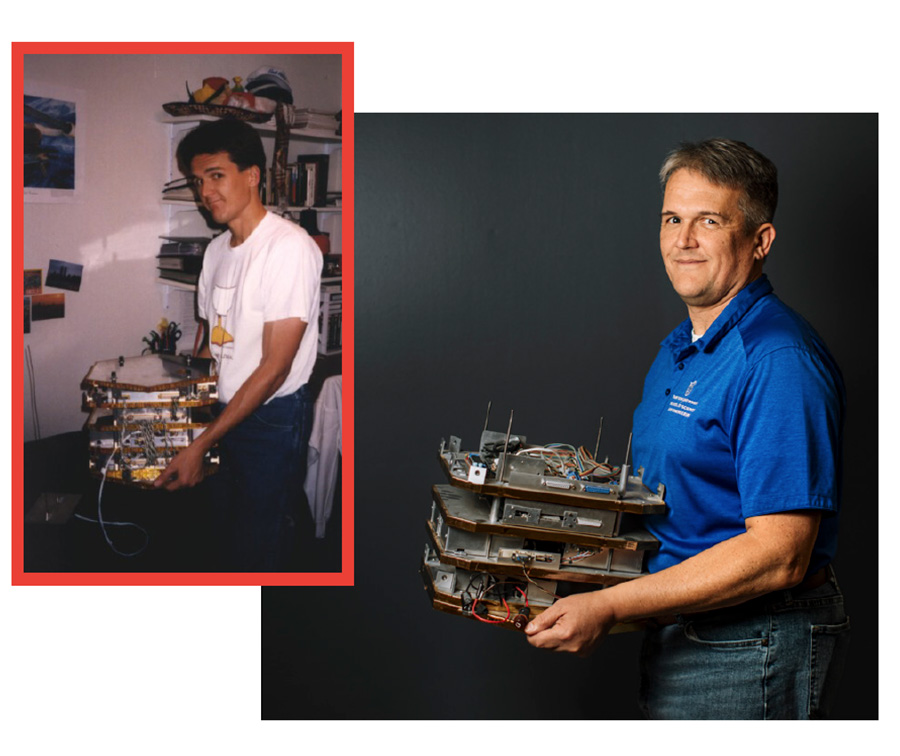
Before there was DARLA, there was Sapphire — Swartwout’s first satellite. At the time, only a handful of spacecraft had ever been built by universities, so the experience of building and launching Sapphire was novel for Swartwout. Sapphire’s launch in 2001 also launched Swartwout’s passion for building satellites and crafting original, educational experiences for the next generation of aerospace engineers.
Swartwout brought his satellite-building program to SLU in 2009. He was inspired by the University’s history in the space field. One of SLU’s most famous graduates is Gene Kranz, who oversaw several historic space missions as chief flight director at NASA, including the first lunar landing, Apollo 11. Kranz’s portrait is featured in a commemorative timeline in McDonnell Douglas Hall, just feet away from the SSRL.
“That history has always been a part of the University,” said Swartwout.
"Despite the fact that there’s no space industry within several hundred miles of St. Louis, students can get involved with a lot of opportunities here. If you want to do space work in St. Louis, you go to SLU," said Swartwout.
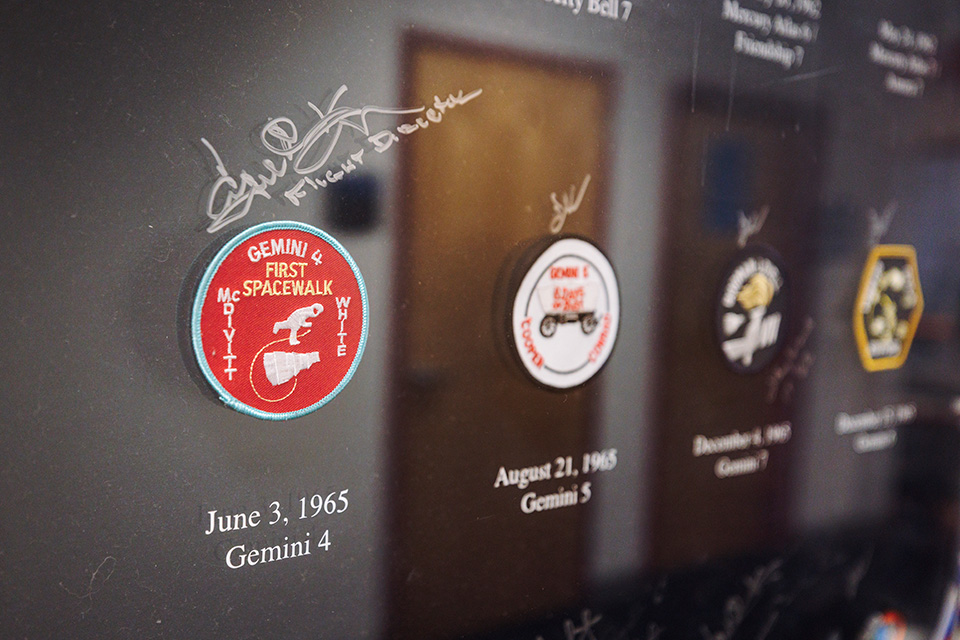
Since joining the University, Swartwout’s research has taken on three dimensions. First, Swartwout partners with an external company to curate a database related to the small satellite industry. Using this database, he publishes reports on the industry and measures degrees of success and failure across all missions. Soon after he began publishing these reports, Swartwout caught the attention of NASA.
“Suddenly, I was being invited to NASA meetings because NASA was trying to decide how much to invest in small satellites,” Swartwout said. “It’s one thing to present a paper at a conference. It’s very different when NASA starts quoting your statistics when making decisions about who to fund!”
Another, newer dimension of Swartwout’s research is autonomous systems in spacecraft — that is, teaching a spacecraft to make its own decisions. This is not often done in the industry due to various risks, but if NASA sends a spacecraft to Jupiter, for example, and something breaks along the way, it could take hours for a solution engineered on Earth to be relayed to the spacecraft.
“We can develop a logical progression so that if something breaks in flight, the spacecraft can correct itself without waiting for a message from Earth,” said Swartwout.
Both of these projects converge in the third and final dimension of Swartwout’s research: undergraduate workforce training centered around the SSRL.
Launching New Careers in the Space Systems Research Lab
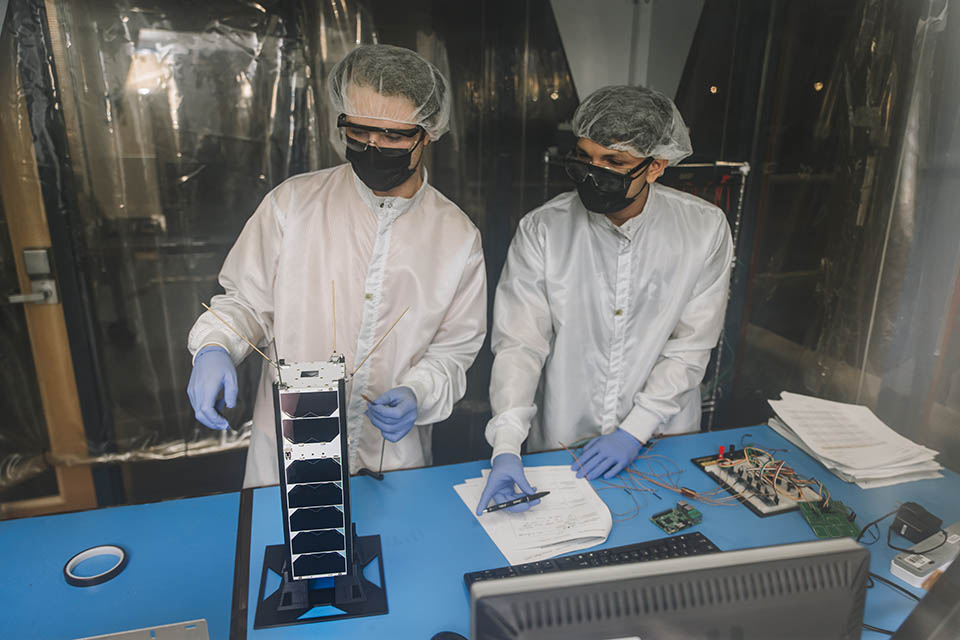
The SSRL gives students hands-on experience in designing, constructing, testing, and launching low-cost spacecraft. It is both a student organization and a fully functioning research lab. The students recruit new members, and Swartwout directs them to different projects overseen by student managers like Dompke. Many of these project managers begin as freshmen and stay with the lab until graduation.
“Students who are interested in these activities can do so from the day they walk through SLU’s doors. You don’t have to have the skills — we’ll teach you those,” said Swartwout.
Nathan Brubaker, a sophomore studying aerospace engineering and computer science, began working in the SSRL as a freshman. At 19 years old, Brubaker already holds an impressive title: chief engineer of the DARLA mission.
“I’ve learned a lot of things in the SSRL that you don’t learn in classrooms. In engineering, you need to get hands-on. Building a satellite, working with the Air Force — those are opportunities you can’t just get in a classroom,” Brubaker said.
As students gain more experience in the lab, they are given more responsibilities. Some of Swartwout’s grants have allowed him to hire interns, and he often pulls from the team leads within the SSRL.
“I get the fortune of working with them first — and I really am fortunate because they often go on to work for the likes of NASA or SpaceX,” Swartwout said.
The success of SSRL alumni at respected organizations like these has brought new attention to the lab’s current students. Swartwout was excited that, for the first time, SpaceX attended SLU’s career fair in 2023.
“Thanks to our alumni, we’re seeing the next group of SLU students get attention,” Swartwout said. “I credit the students for this: We get one student hired in a particular area, and they tend to be so impressive that now any other SLU applicant immediately gets slotted into a different category.”
Launching DARLA
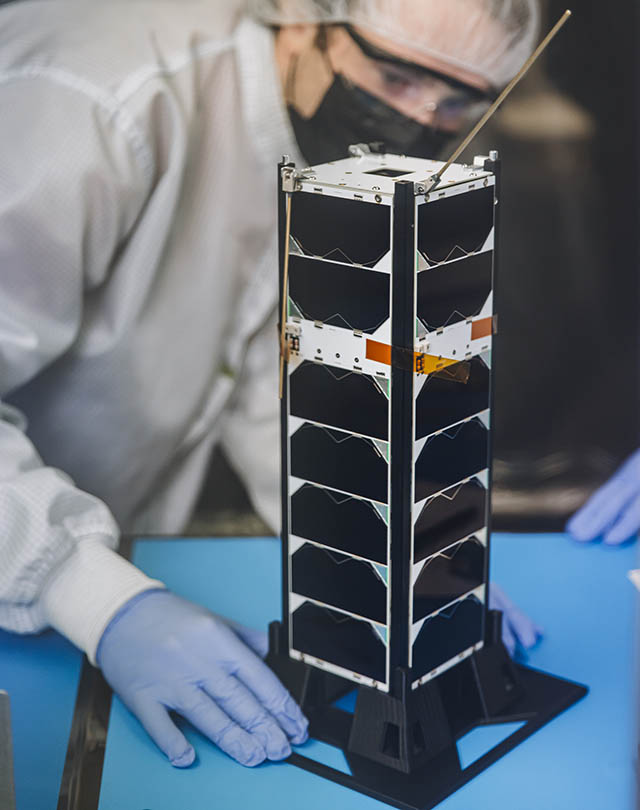
One of the goals of the SSRL is to reduce the immense costs associated with professional space missions. Swartwout sees an opportunity for universities to reduce risk on such missions, and in doing so, provide novel experiences for students interested in the field. One way that universities can absorb risk is by doing missions that test or demonstrate different components of larger missions. DARLA is one such mission.
DARLA is a single satellite mission designed to test a number of the components of a larger, eight-satellite mission called DORRE. DORRE is an experiment in spacecraft autonomy. Once DORRE’s eight satellites are in orbit, a team back on Earth will transmit various commands that the constellation will then perform.
“A while ago, a volcano erupted in Tonga, and half the island was gone. So there’s this sudden need to generate information about a specific region of the world. That’s the idea [of DORRE]. We’ll send a message to the network: We want everything on this geographic location — here’s the coordinate and the timeframe,” Swartwout said. “Risk retirement is the fancy term for [DARLA]. We’re identifying things that would make [DORRE] really difficult, and we’re testing or demonstrating them on a single spacecraft.”
That spacecraft is about 30 centimeters long and 10 centimeters on its side — kind of like a loaf of bread, as Swartwout put it. Through a bit of clever software and design wizardry from the students, one half of DARLA will be autonomously controlled while the other half will be controlled by a team of students back on Earth. The autonomous system and the student operators will be simultaneously given a set of identical problems to solve. This will produce quantitative evidence as to how effective an automated system is compared to a human-controlled system. The team anticipates that the autonomous system will be faster, but it may make more mistakes than the student team.
But the SSRL team needs to get DARLA into orbit first. As part of NASA’s CubeSat Launch Initiative program (CSLI), the mission empowers students to take the lead on every aspect of it.
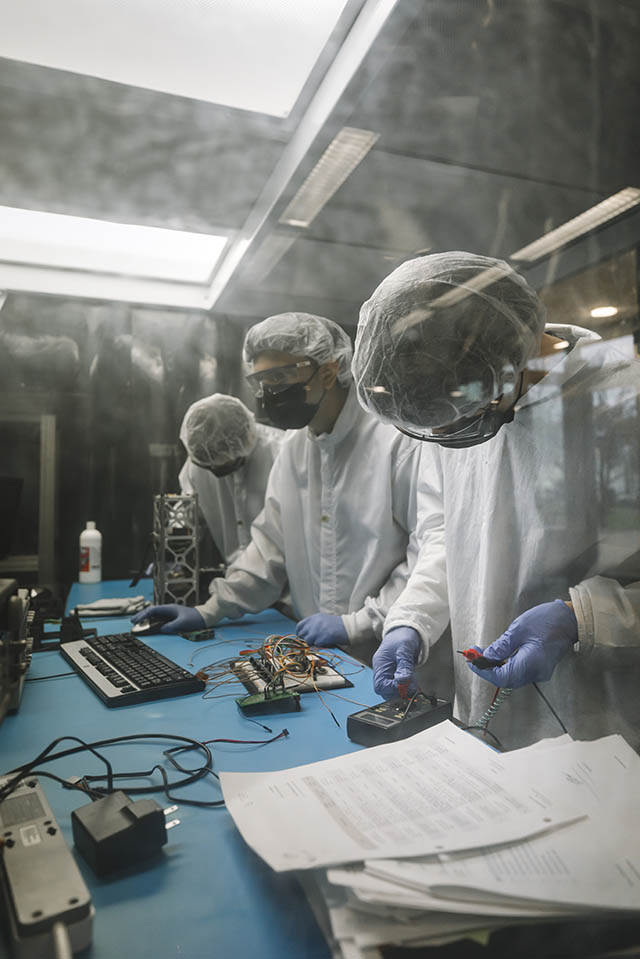
As chief engineer of the mission, Brubaker is responsible for bringing DARLA’s various systems, such as power and communications, together into one working satellite. Brubaker drops into the lab whenever he has the time between classes. The work takes up a lot of his free time, but he doesn’t mind as a lot of the other students involved have become friends and mentors.
“It’s a pretty close group because we’ve been working on this together for a long time,” Brubaker said. “I’ve picked up a lot from working with [Dompke] and other upperclassmen, especially over the summer when we were spending like 40 hours a week working on DARLA.”
As program manager, Dompke works directly with NASA Launch Services to keep the mission on schedule; while final exams are more than enough for most college students to manage at the end of the year, Dompke was also taking meetings with NASA.
You don’t find space missions like this at too many colleges,” Dompke said. “It’s really cool to be a part of all of it, to work with Launch Services to get your spacecraft on a missile system.”
Dompke is also fine-tuning DARLA’s telemetry system — a system that uses various sensors to collect and transmit data — testing the range of the satellite’s sensors, and working with the launch provider to plan vibration tests. These tests evaluate workmanship, ensuring that none of the satellite’s parts come loose in a high-vibration environment like the back of a rocket. They also evaluate vehicle safety.
“Your natural frequency is where your spacecraft will be most excited, so you need to ensure that you don’t match the natural frequency of the launch vehicle because that tends to end in explosion,” Dompke explained. “We’re looking good, though! All of our simulations show we’re way above that value.”
Details like these are absolutely critical; there’s little to no margin of error in space missions.
“If you’re driving down the highway and one of your lug nuts falls off your wheel, ideally that was not the only one on your wheel, so you’ll probably be fine. But losing one fastener could be the end of your space mission,” Swartwout said. “One thing going wrong can be enough to torpedo your entire mission.”
Launching in T-Minus —
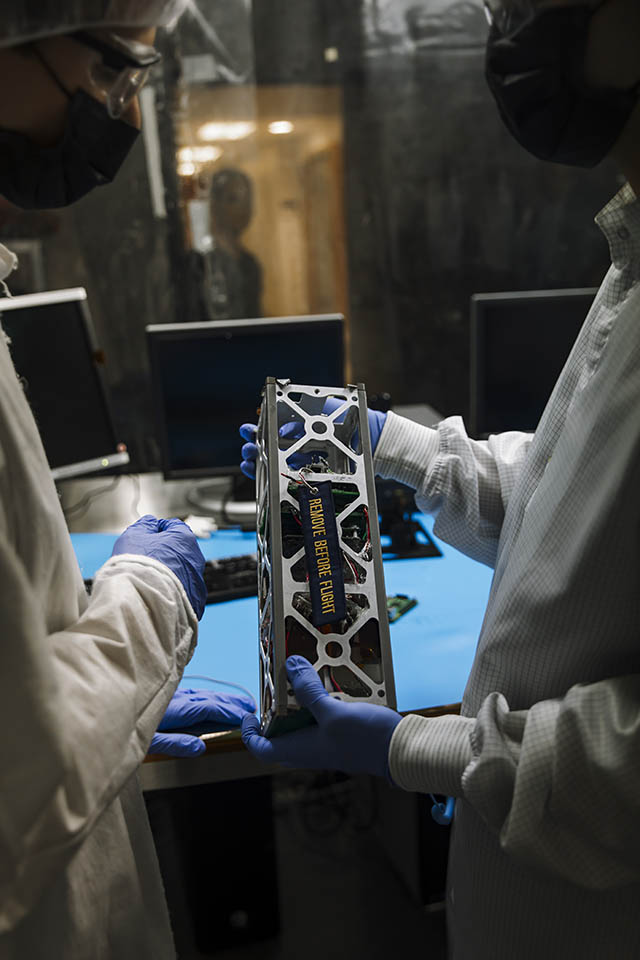
As DARLA’s 2024 launch date approaches, Dompke and Brubaker are both excited and anxious for their first satellite launch. While everyone is feeling confident ahead of the date, they also know that, as with all small satellite missions, failure is a distinct possibility. Any number of things could go wrong. But they refuse to let that anxiety get the best of them.
“I’m a little worried about something going wrong during launch, but that’s out of our control,” Brubaker said. “I’m worrying about stuff that’s in our control.”
Swartwout can relate to his students’ mixed feelings. He’s experienced both successes and failures during previous satellite launches. He’s even tried to leave the field a few times, but he keeps getting pulled back in — not unlike one of his satellites in orbit.
Swartwout occasionally finds himself commiserating with colleagues and former classmates at professional conferences, reflecting on the exhilarating highs and heartbreaking lows of this work.
“We’ve had students work on spacecraft that haven’t worked. We’ve built spacecraft that failed and fell into the Pacific Ocean. It takes so long, and there’s so much potential heartache involved. Yet, here we all are at these conferences every year. So somehow, we can’t stop doing this!” Swartwout said. “And giving students a pathway here at SLU — if space is something they want to do — is something I really do enjoy.”
Swartwout is confident in his students and optimistic about DARLA’s chances. He laughed as his gaze drifted upward.
“There’s just something about getting one into orbit.”
Story by Kevin Lynch, senior communications manager in the Office of the Vice President for Research.
This piece was written for the 2023 SLU Research Institute Annual Impact Report. The Impact Report is printed each spring to celebrate the successes of our researchers from the previous year and share the story of SLU's rise as a preeminent Jesuit research university. More information can be found here.

















